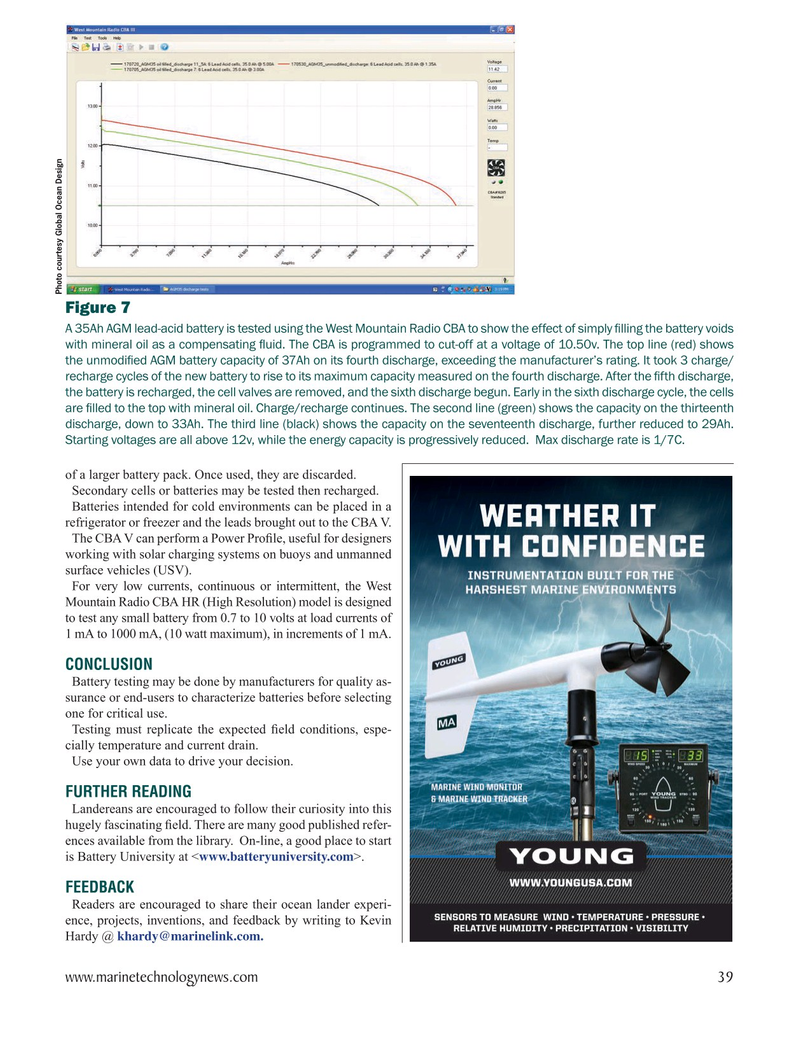
Page 39: of Marine Technology Magazine (March 2024)
Read this page in Pdf, Flash or Html5 edition of March 2024 Marine Technology Magazine
Photo courtesy Global Ocean Design
Figure 7
A 35Ah AGM lead-acid battery is tested using the West Mountain Radio CBA to show the effect of simply ? lling the battery voids with mineral oil as a compensating ? uid. The CBA is programmed to cut-off at a voltage of 10.50v. The top line (red) shows the unmodi? ed AGM battery capacity of 37Ah on its fourth discharge, exceeding the manufacturer’s rating. It took 3 charge/ recharge cycles of the new battery to rise to its maximum capacity measured on the fourth discharge. After the ? fth discharge, the battery is recharged, the cell valves are removed, and the sixth discharge begun. Early in the sixth discharge cycle, the cells are ? lled to the top with mineral oil. Charge/recharge continues. The second line (green) shows the capacity on the thirteenth discharge, down to 33Ah. The third line (black) shows the capacity on the seventeenth discharge, further reduced to 29Ah.
Starting voltages are all above 12v, while the energy capacity is progressively reduced. Max discharge rate is 1/7C. of a larger battery pack. Once used, they are discarded.
Secondary cells or batteries may be tested then recharged.
Batteries intended for cold environments can be placed in a refrigerator or freezer and the leads brought out to the CBA V.
The CBA V can perform a Power Pro? le, useful for designers working with solar charging systems on buoys and unmanned surface vehicles (USV).
For very low currents, continuous or intermittent, the West
Mountain Radio CBA HR (High Resolution) model is designed to test any small battery from 0.7 to 10 volts at load currents of 1 mA to 1000 mA, (10 watt maximum), in increments of 1 mA.
CONCLUSION
Battery testing may be done by manufacturers for quality as- surance or end-users to characterize batteries before selecting one for critical use.
Testing must replicate the expected ? eld conditions, espe- cially temperature and current drain.
Use your own data to drive your decision.
FURTHER READING
Landereans are encouraged to follow their curiosity into this hugely fascinating ? eld. There are many good published refer- ences available from the library. On-line, a good place to start is Battery University at
FEEDBACK
Readers are encouraged to share their ocean lander experi- ence, projects, inventions, and feedback by writing to Kevin
Hardy @ [email protected].
www.marinetechnologynews.com 39
MTR #3 (34-47).indd 39 4/4/2024 11:11:26 AM

 38
38

 40
40
